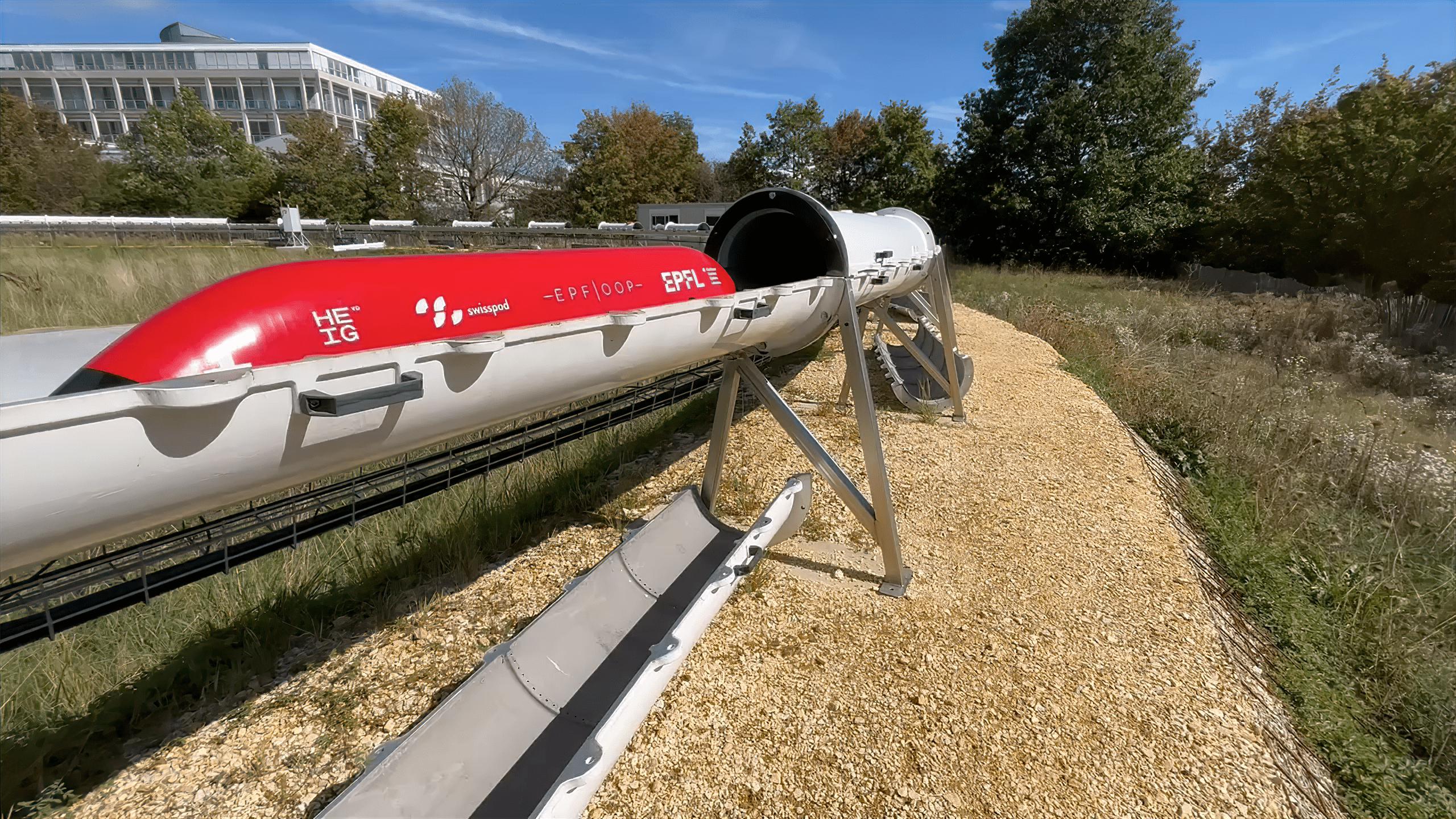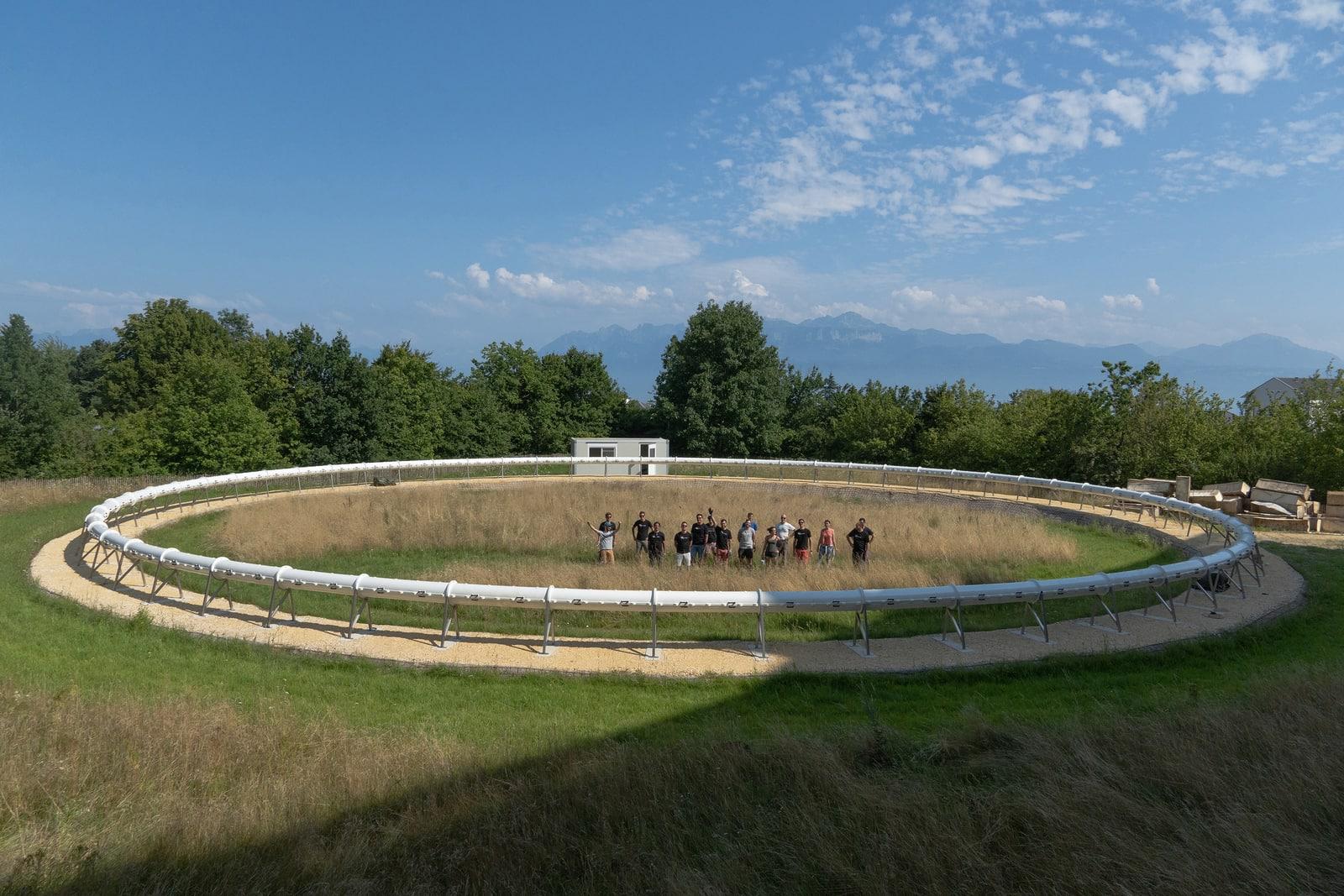
The pod reach a top speed of 40.7km/h in reduced scale, a full-scale equivalent of 488.2km/h. © Swisspod
As part of the LIMITLESS project, scientists from EPFL, HEIG-VD and Swisspod have completed the longest-ever vacuum capsule journey in Europe's first operational Hyperloop test facility.
The LIMITLESS (Linear Induction Motor Drive for Traction and Levitation in Sustainable Hyperloop Systems) project, carried out by EPFL, the School of Business and Engineering Vaud (HEIG-VD) and Swisspod Technologies, aims at creating a sustainable and efficient future transportation system based on light infrastructure. The consortium achieved a significant milestone, completing the full-scale equivalent of a 141.6 km hyperloop journey (11.8 km in reducedscale), and top speeds of up to 488.2 km/h (40.7 km/h in reduced scale) within a controlled low-pressure environment. Recently, the results were unveiled during the Hyperloop Day event at EPFL.
This record was conducted at the hyperloop testing facility located at EPFL. This cutting-edge structure, designed as a circular loop track supports the rapid prototyping and testing of different technologies required by the hyperloop. The infrastructure has a diameter of 40 centimeters and a circumference of 125.6 meters. It is a scaled-down version (1:12) of the hyperloop system described in the EPFL doctoral thesis of Denis Tudor, the CEO of Swisspod, allowing for a direct correlation between the test results and full-scale performance.

The success of the experiment holds significant implications for the high-speed transportation sector, demonstrating key principles of hyperloop technology and its viability for the future of sustainable and fast travel. Composed of two main elements, a fully-electric vehicle, and a low-pressure tube infrastructure, hyperloop has the potential to disrupt intra-continental travels, while being sustainable at the same time.
The scientists rely on a passive infrastructure, resulting in increased efficiency and reduced implementation costs. Therefore, most of the efforts are focused on developing a novel Linear Induction Motor (LIM), a key part of the hyperloop propulsion system, designed to deliver improved performance at high speeds. This topic is the subject of the PhD thesis of Simone Rametti at EPFL's Distributed Electrical Systems Laboratory (DESL).
"The LIMITLESS project provides an understanding of several fundamental aspects related to the high-speed electromagnetic propulsion of hyperloop capsules. By leveraging this knowledge, we were able to integrate levitation and propulsion functionalities into a single motor with very high energy conversion efficiency," explains Mario Paolone, professor at DESL.
Back-to-back records set across 82 tests
Within the LIMITLESS project, supported by Innosuisse, the team conducted a total of 82 tests. The experiments at LIMITLESS replicated a hyperloop capsule's trajectory within a controlled low-pressure environment operated at 50 millibars. The longest hyperloop mission covered a distance of 11.8 km, while the top speed achieved was 40.7 km/h. In a full-scale system, this directly translates to a journey of 141.6 km, which is about the distance between Geneva and Bern, or San Francisco to Sacramento, and speeds of up to 488.2 km/h. This was achieved with a fully autonomous capsule in terms of navigation, energy supply and propulsion. The infrastructure does not transfer any power to the capsule which contains the sole source of energy for its propulsion and levitation.
The team closely monitored the performance of vital subsystems such as the propulsion, communication infrastructure, power electronics, and thermal management. They assessed energy consumption, thrust variations, LIM response, and control during acceleration, cruising, coasting, and braking scenarios.
"Our infrastructure operates as a closed loop, so it truly is LIMITLESS, free from any inherent length limitations. The way our track was designed enables us to consider everything - the capsule's energy efficiency, the propulsion systems, and more - in ways that other hyperloop infrastructures cannot. Our innovative approach to building the hyperloop system provides us a vital platform for testing and refining different technologies, ensuring optimal performance and adaptability," explains Cyril Dénéréaz, the CTO of Swisspod.
Fast-Track to the Future
Future tests at the EPFL facility aim to further validate more efficient versions of the LIM-based hyperloop propulsion and levitation as well as explore the system's real-world capabilities, limitations, and prospects, while offering vital data for accelerating the path to market deployment. This strategic approach involves incrementally advancing the technology in controlled, reduced-scale settings, allowing the engineering and research team to achieve cost-effective development and rapid iterations. This method enables systematic improvements in efficiency, safety, and speed before implementing the technology on a larger scale. The technologies developed through the LIMITLESS project can impact a variety of sectors beyond the hyperloop industry, including automotive, metro systems, rail, and aerospace.

"This milestone brings us closer to a future where hyperloop becomes a catalyst for societal change. Putting our years of technological innovation to the test is a critical step in pushing the development and deployment of efficient hyperloop technologies worldwide. We'll soon begin testing our first hyperloop freight transportation product at the larger-scale facility we're building in the U.S. This is a key step toward making hyperloop for passengers a reality and changing how we connect, work, and live," says Denis Tudor, the CEO of Swisspod.






